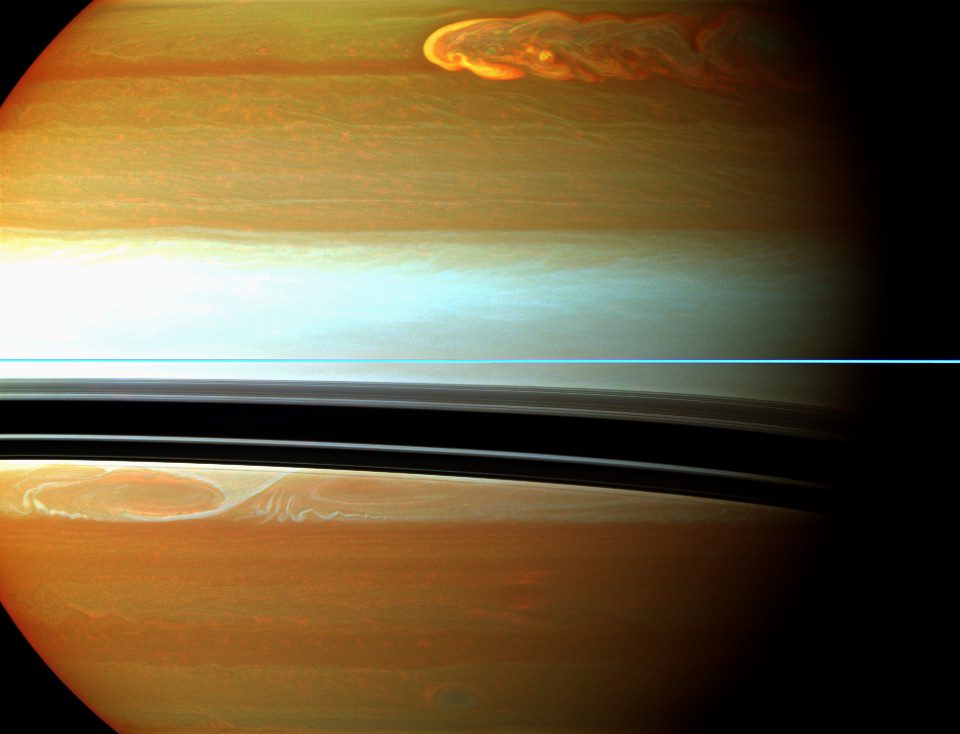We're spoiled, don't you know? It was 10 years ago today that the Cassini spacecraft entered Saturn's system, and it has been busily beaming back pictures of the ringed planet and its (many) moons ever since. We've learned more about seasons on Titan, investigated plumes on Enceladus, and examined phenomena such as auroras on Saturn.
Embedded in this story are 20 of our favourite pictures from Universe Today's archive of Cassini discoveries, which you can check out below the jump.
It's only a fraction of the more than 332,000 images received from the spacecraft, which is in excellent health and has seen its mission extended three times past its original 2008 expiry date. Additionally, more than 3,000 scientific papers have been generated. More cool stats
in this NASA infographic
.
And by the way, we're not the only ones assembling memorable images to mark the anniversary. Check out
NASA's favourite Cassini pictures of the past decade
, or our friend
Phil Plait's Bad Astronomy list
. Also, here is NASA's opinion
of the top 10 discoveries at the ringed planet
.
While thinking about Cassini, also don't forget Huygens, the lander that descended to the surface of Titan in 2005. More on that
in this past Universe Today anniversary story
.
[caption id="attachment_107631" align="alignnone" width="580"]
The full mosaic from the Cassini imaging team of Saturn on July 19, 2013… the "Day the Earth Smiled"[/caption]
[caption id="attachment_57467" align="alignnone" width="580"]
In this unique mosaic image combining high-resolution data from the imaging science subsystem and composite infrared spectrometer aboard NASA's Cassini spacecraft, pockets of heat appear along one of the mysterious fractures in the south polar region of Saturn's moon Enceladus. Image credit: NASA/JPL/GSFC/SWRI/SSI[/caption]
[caption id="attachment_84556" align="alignnone" width="580"]
Saturn, imaged by Cassini on approach. Credit: CICLOPS[/caption]
[caption id="attachment_66954" align="alignnone" width="580"]
Titan and Dione as seen by Cassini. Credit: NASA/JPL/Space Science Institute[/caption]
[caption id="attachment_67449" align="alignnone" width="580"]
This image taken by the Cassini orbiter on Oct. 15, 2007, shows Saturn's A and F rings, the small moon Epimetheus and smog-enshrouded Titan, the planet's largest moon. The image is colorized to approximate the scene as it might appear to human eyes. (Credit: NASA/JPL/Space Science Institute)[/caption]
[caption id="attachment_75051" align="alignnone" width="580"]
Cassini imaging scientists used views like this one to help them identify the source locations for individual jets spurting ice particles, water vapor and trace organic compounds from the surface of Saturn's moon Enceladus. Credit: NASA[/caption]
[caption id="attachment_64648" align="alignnone" width="500"]
Raw image from Cassini on May 18. Credit: NASA/JPL/SSI[/caption]
[caption id="attachment_81857" align="alignnone" width="580"]
Hemispheric color differences on Saturn's moon Rhea are apparent in this false-color view from NASA's Cassini spacecraft. This image shows the side of the moon that always faces the planet. Image Credit: NASA/JPL/SSI[/caption]
[caption id="attachment_30052" align="alignnone" width="580"]
Three of Saturn's moons bunch together in this image by Cassini. Credit: NASA/JPL/Space Science Institute. Click for larger image.[/caption]
[caption id="attachment_83097" align="alignnone" width="430"]
This mosaic of Titan was created from the first flyby of the moon by Cassini in 2004. Credit: NASA/JPL/SS[/caption]
[caption id="attachment_93432" align="alignnone" width="409"]
Phoebe imaged by the Cassini spacecraft. Image Credit: NASA[/caption]
[caption id="attachment_110426" align="alignnone" width="577"]
Cassini VIMS image of specular reflections in one of Titan's lakes from a flyby on July 24, 2012 (NASA/JPL-Caltech/SSI/Jason W. Barnes et al.)[/caption]
[caption id="attachment_83008" align="alignnone" width="500"]
A crescent Dione was seen by Cassini on January 29, 2011 from approximately 767,922 kilometers away. Credit: NASA/JPL/SSI[/caption]
[caption id="attachment_80330" align="alignnone" width="500"]
Rhea, as seen by Cassini. Credit: NASA[/caption]
[caption id="attachment_77713" align="alignnone" width="580"]
Cassini captured this startling image of Saturn's moon Hyperion. Photo Credit: NASA/JPL[/caption]
[caption id="attachment_80812" align="alignnone" width="580"]
ets of water ice particles spew from Saturn's moon Enceladus in this image obtained by NASA's Cassini spacecraft on Aug. 13, 2010. Image credit: NASA/JPL/SSI[/caption]
[caption id="attachment_74390" align="alignnone" width="500"]
This false-color composite image shows Saturn's rings and southern hemisphere. The composite image was made from 65 individual observations by Cassini's visual and infrared mapping spectrometer in the near-infrared portion of the light spectrum on Nov. 1, 2008. Credit: NASA/JPL/University of Arizona[/caption]
[caption id="attachment_69503" align="alignnone" width="580"]
This mosaic of images from NASA's Cassini spacecraft shows three fan-like structures in Saturn's tenuous F ring. Such "fans" suggest the existence of additional objects in the F ring. Image credit: NASA/JPL/SSI[/caption]
[caption id="attachment_22349" align="alignnone" width="401"]
Cassini came within 25 kilometers (15.6 miles) of the surface of Enceladus on Oct. 5, 2008. Image credit: NASA/JPL/Space Science Institute[/caption]
 Universe Today
Universe Today
